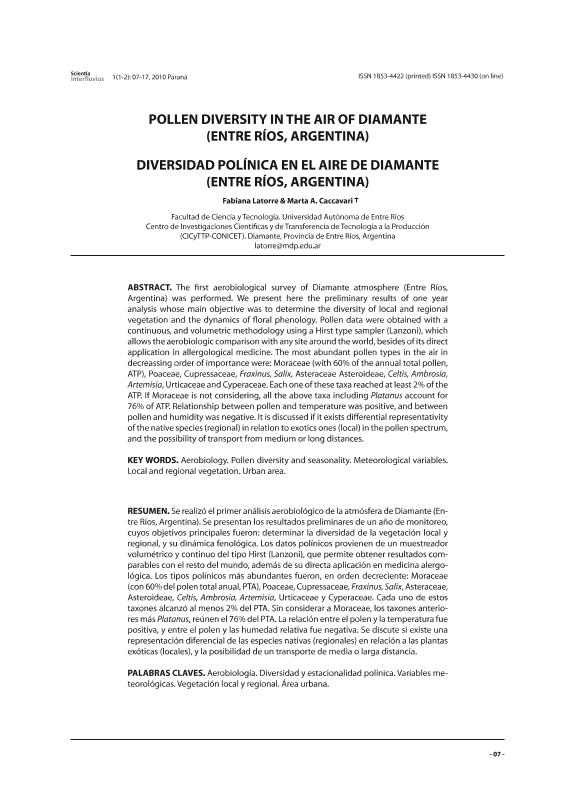Artículo
Se realizó el primer análisis aerobiológico de la atmósfera de Diamante (Entre Ríos, Argentina). Se presentan los resultados preliminares de un año de monitoreo, cuyos objetivos principales fueron: determinar la diversidad de la vegetación local y regional, y su dinámica fenológica. Los datos polínicos provienen de un muestreador volumétrico y continuo del tipo Hirst (Lanzoni), que permite obtener resultados comparables con el resto del mundo, además de su directa aplicación en medicina alergológica. Los tipos polínicos más abundantes fueron, en orden decreciente: Moraceae (con 60% del polen total anual, PTA), Poaceae, Cupressaceae, Fraxinus, Salix, Asteraceae Asteroideae, Celtis, Ambrosia, Artemisia, Urticaceae y Cyperaceae. Cada uno de estos taxones alcanzó al menos 2% del PTA. Sin considerar a Moraceae, los taxones anteriores más Platanus, reúnen el 76% del PTA. La relación entre el polen y la temperatura fue positiva, y entre el polen y las humedad relativa fue negativa. Se discute si existe una representación diferencial de las especies nativas (regionales) en relación a las plantas exóticas (locales), y la posibilidad de un transporte de media o larga distancia. The first aerobiological survey of Diamante atmosphere (Entre Ríos, Argentina) was performed. We present here the preliminary results of one year analysis whose main objective was to determine the diversity of local and regional vegetation and the dynamics of floral phenology. Pollen data were obtained with a continuous, and volumetric methodology using a Hirst type sampler (Lanzoni), which allows the aerobiologic comparison with any site around the world, besides of its direct application in allergological medicine. The most abundant pollen types in the air in decreassing order of importance were: Moraceae (with 60% of the annual total pollen, ATP), Poaceae, Cupressaceae, Fraxinus, Salix, Asteraceae Asteroideae, Celtis, Ambrosia, Artemisia, Urticaceae and Cyperaceae. Each one of these taxa reached at least 2% of the ATP. If Moraceae is not considering, all the above taxa including Platanus account for 76% of ATP. Relationship between pollen and temperature was positive, and between pollen and humidity was negative. It is discussed if it exists differential representativity of the native species (regional) in relation to exotics ones (local) in the pollen spectrum, and the possibility of transport from medium or long distances.
Pollen diversity in the air of Diamante (Entre Ríos, Argentina)
Título:
Diversidad polínica en el aire de Diamante (Entre Ríos, Argentina)
Fecha de publicación:
12/2009
Editorial:
Universidad Autónoma de Entre Ríos
Revista:
Scientia Interfluvius
ISSN:
1853-4430
e-ISSN:
1853-4422
Idioma:
Inglés
Tipo de recurso:
Artículo publicado
Clasificación temática:
Resumen
Palabras clave:
aerobiología
,
polen atmosférico
,
ambiente urbano
,
fuentes emisoras
Archivos asociados
Licencia
Identificadores
Colecciones
Articulos(CICYTTP)
Articulos de CENTRO DE INV.CIENT.Y TRANSFERENCIA TEC A LA PROD
Articulos de CENTRO DE INV.CIENT.Y TRANSFERENCIA TEC A LA PROD
Articulos(IIMYC)
Articulos de INSTITUTO DE INVESTIGACIONES MARINAS Y COSTERAS
Articulos de INSTITUTO DE INVESTIGACIONES MARINAS Y COSTERAS
Citación
Latorre, Fabiana; Caccavari, Marta Alicia; Pollen diversity in the air of Diamante (Entre Ríos, Argentina); Universidad Autónoma de Entre Ríos; Scientia Interfluvius; I; 1-2; 12-2009; 1-11
Compartir




